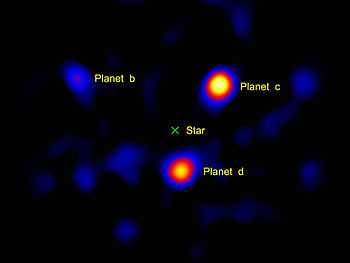Vortex coronagraph

A Vortex coronagraph is a type of optical instrument, that allows seeing very faint objects near very bright objects, that would normally obscured by glare. For example, extrasolar planets near their host star, as seen from Earth or space telescopes in Earth's solar system. It is a type of coronagraph.
Up until the year 2010, telescopes could only directly image exoplanets under exceptional circumstances. Specifically, it is easier to obtain images when the planet is especially large (considerably larger than Jupiter), widely separated from its parent star, and hot so that it emits intense infrared radiation. However in 2010 a team from NASAs Jet Propulsion Laboratory demonstrated that a vortex coronagraph could enable small telescopes to directly image planets.[1] They did this by imaging the previously imaged HR 8799 planets using just a 1.5 m portion of the 5 meter Hale Telescope.